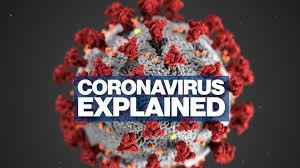COVID-19 is the name given to the airborne illness that has created a global pandemic. It’s caused by severe acute respiratory syndrome coronavirus 2 (SARS-CoV-2). This new infectious disease first emerged in Hubei province, China, in December 2019 and was associated with a large seafood and animal market in Wuhan. Coronaviruses mainly cause respiratory and gastrointestinal tract infections, including colds. Coronaviruses are widely distributed in animals, and frequent cross-species infections are likely to happen in people.
Viruses are made of proteins and DNA or RNA sequences covered with a protein coat to attach to healthy cells. Once attached, viruses send a DNA sequence into the healthy cells that forces them to make copies of the virus. Once enough copies of the virus are made inside affected cells, the cell bursts (lysis), and new viruses are released into the body.
Coronaviruses are RNA viruses ranging from 26 to 32 kilobases in length. This means their genome is much shorter than those of bacterial or human body cells. The exterior coat of SARS-CoV-2 is a Coronavirus characterized by a sphere surrounded by receptors that puncture cell membranes. The appearance of the virus under a microscope makes it look like a crown. That’s why they are known as Coronaviruses. Viruses are usually much smaller than the cells they infect and are not easily detected by cells that work on bacterial infections, foreign bodies, and microbial parasites. Viruses are different from bacteria and microorganisms and are treated with vaccines, not antibiotics.
Coronaviruses are a common form of virus, including viruses that cause head colds and runny noses. SARS-Cov-2 is different from other Coronaviruses because it is very infectious, and we currently have few countermeasures to stop the infection in the body and in public. The virus can be transmitted from person to person by breathing in droplets that carry the virus known as bioaerosols.
How can we protect ourselves?
Bioaerosol contact can be reduced by a combination of ventilation controls, personal protective equipment (PPE), and administrative controls such as social distancing and sheltering in place.
The general strategy for reducing the chance of transmission for COVID-19 is similar to the strategy used by hazardous materials professionals to reduce exposure to any hazardous environmental agent. Exposure controls are managed by – in order of preference-
- Engineering controls such as ventilation systems and air scrubbers
- Administrative controls such as social distancing, sheltering, and universal precautions such as handwashing.
- PPE such as masks, face shields, eyeglasses, goggles, respirators, gloves, and protective clothing are usually the last resort in contamination management.
Bioaerosol droplets that contain the virus can also be picked up in the soft tissues in your eyes. If you cover your eyes with glasses or face shields or goggles, you can reduce your chance of getting infected. If you rub your eyes after touching a bioaerosol, you increase your risk of infection. This is why coverings your nose, mouth, and eyes and hands, can protect yourself and others in controlling infection and transmission of the virus.
The same measures that are being used to manage SARS-Cov-2 follow OSHA, NIH, and CDC protocols for reducing exposure to any chemical, radiation, and biohazard agent.
Who can we go to for more information?
Industrial Hygienists for workplace environment evaluations and PPE for the workplace:
https://www.aiha.org/public-resources/consumer-resources/coronavirus_outbreak_resources
Workplace standards for PPE and hazardous materials management
https://www.osha.gov/SLTC/covid-19/
Research on COVID-19 and treatments – FDA and NIAID/NIH
https://www.fda.gov/news-events
https://www.niaid.nih.gov/news-events/novel-coronavirus-sarscov2-images
Information on disease spread and public health measures
https://www.naccho.org/programs/our-covid-19-response
https://www.cdc.gov/coronavirus/2019-ncov/index.html
https://www.mass.gov/resource/information-on-the-outbreak-of-coronavirus-disease-2019-covid-19
Reference articles on COVID-19
https://www.ncbi.nlm.nih.gov/pmc/articles/PMC7180649/
About the writer:
Richard Tharin, MS, RAC, is a scientist with The Cerneos Group, LLC. He provides scientific and regulatory advice to biotech, diagnostic and drug companies to develop innovative products to treat, diagnose, and mitigate exposure to infectious disease agents. He was worked in the field for more than 20 years in industry and government service and has direct experience with the FDA and NIH on vaccine and diagnostic development. His thesis research was on biodefense and infectious disease management. He has field experience in Industrial Hygiene, Hazardous Materials Management, Respiratory Protection and HAZWOPER Emergency Response.

